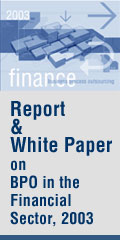|


|
Indian public sector banks perform better than private banks in terms of both deposits and credit
Public sector banks in India have outpaced their private peers in terms of both market share in deposits and credit at the second quarter ending on September 30th, 2008.
Banks’ gross credit grew 26%, as per the latest data available from the RBI. This growth is at par with last year’s performance. But things aren’t the same at the micro level as most private sector banks have significantly slowed their asset growth compared to last year.
ICICI Bank’s balance sheet size has actually shrunk in the past nine months. HDFC Bank posted a growth of only 18.4% in its balance sheet (post merger with Centurion Bank of Punjab) as of end of the September ’08 quarter, compared to 46% growth in FY08. Also, the focus has completely shifted from chasing growth targets to maintaining asset quality, as non-performing assets (NPAs) are rising. The NPAs for the two largest banks, ICICI Bank and SBI, have increased of late. And there’s more to come, as analysts expect that NPAs will reach their peak only at the end of FY10.
According to the Reserve Bank data, nationalized banks as well as the State Bank group share of total deposits raised to 48.6% and 23.2% respectively during this period as compared to 47.9% and 22.6% respectively, recorded for the same period a year ago. On the other hand private banks share declined from 20.3% to 19.4% and even the foreign banks clocked a dip in their share from 6.1% to 5.8%.
Also the credit share of nationalized banks rose marginally to 47.9% from 47%, a year ago. The share of SBI group increased to 23.4% from 22.9% during this one year period. Similarly the credit share of private banks declined to 19.3% from 20.6% but the foreign banks share rose to 7.2% from 6.8%.
As of September 30th 2008, the credit-deposit ratio (CDR) for nationalized banks was recorded at 73.8%. SBI group has a CDR of 75.5%. Where as the CDR for private banks and foreign bank was 74.6% and 92.4% respectively. The regional rural banks were recorded at 56.9%.
All together the CDR for commercial banks was recorded at 74.9%. In fact banks in Tamil Nadu clocked the highest CDR at 113% followed by Chandigarh at 107.4%.
However, the most interesting aspect of the change this year has been that public sector banks have shown aggression in tough times. They are trying hard to shed their image of industry laggards and this is now showing results. For instance, Bank of India (BoI) and Bank of Baroda (BoB) have grown their balance sheets by a higher rate as of end-September ’08 than six months ago. This shows that these banks have not only weathered the downturn, but they have also used it as an opportunity to consolidate their operations.
CLICK FOR Updates on Results of Banks in India
CLICK FOR Updates on Domestic Lending Rates
CLICK FOR MORE FEATURES & STORIES
Salaried Indians prefer PSU banks For deposits, loans & banking services
|
|
|